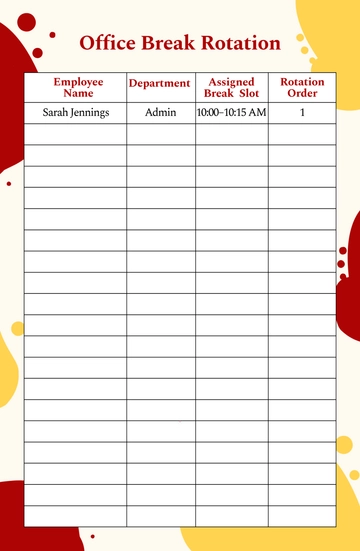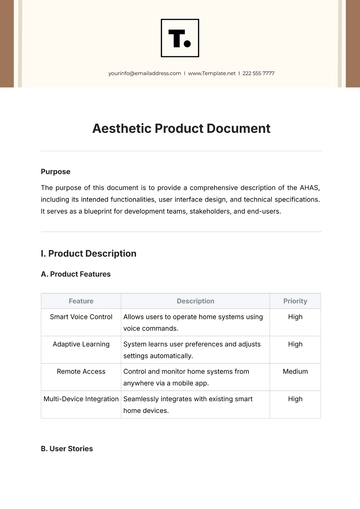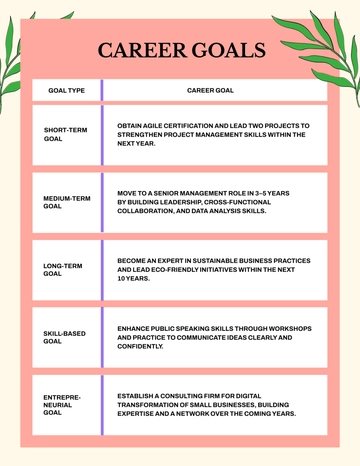Free Aesthetic Product Document

Purpose
The purpose of this document is to provide a comprehensive description of the AHAS, including its intended functionalities, user interface design, and technical specifications. It serves as a blueprint for development teams, stakeholders, and end-users.
I. Product Description
A. Product Features
Feature | Description | Priority |
|---|---|---|
Smart Voice Control | Allows users to operate home systems using voice commands. | High |
Adaptive Learning | System learns user preferences and adjusts settings automatically. | High |
Remote Access | Control and monitor home systems from anywhere via a mobile app. | Medium |
Multi-Device Integration | Seamlessly integrates with existing smart home devices. | High |
B. User Stories
As a user, I want to be able to control my lighting and temperature settings using voice commands, so I can have a hands-free experience.
As a user, I want the system to learn and adapt to my routines, so it can automatically adjust settings to my preferences.
As a user, I want to access and control my home systems remotely, so I can manage my home from anywhere.
II. Technical Requirements
A. System Architecture
The AHAS will be built on a modular architecture to ensure scalability and flexibility. The core components include:
Central Control Hub: The main processor unit that integrates all system modules.
Communication Interfaces: Support for Wi-Fi, Bluetooth, and Zigbee protocols.
Data Storage: Secure cloud storage for user data and system logs.
B. Performance Metrics
Metric | Specification |
|---|---|
Response Time | Less than 1 second for voice command processing. |
Uptime | 99.9% uptime guaranteed. |
Data Security | End-to-end encryption for all data transmissions. |
III. User Interface Design
A. Mobile App
The mobile application will feature a user-friendly interface with the following elements:
Dashboard: Overview of all connected devices and their statuses.
Settings Menu: Customization options for device preferences and automation rules.
Notifications: Real-time alerts for system updates and potential issues.
B. Control Panel
The physical control panel will include:
Touchscreen Interface: Intuitive controls for manual adjustments.
Voice Activation Button: Quick access to voice control features.
Status Indicators: Visual cues for system health and connectivity.
IV. Compliance and Standards
A. Industry Standards
The AHAS will adhere to the following standards:
ISO/IEC 27001: Information security management.
IEEE 802.11: Wi-Fi communication protocols.
Zigbee Alliance: Standards for Zigbee communication.
B. Regulatory Requirements
Compliance with regional and international regulations will be ensured, including:
FCC: Federal Communications Commission regulations for electronic devices.
CE: Conformité Européenne for products sold in Europe.
V. Project Timeline
A. Milestones
Milestone | Date | Description |
|---|---|---|
Initial Planning | January 2050 | Define project scope and objectives. |
Design Phase | March 2050 | Complete UI/UX and technical designs. |
Development | June 2050 | Start development and integration. |
Testing & QA | September 2050 | Perform system testing and quality assurance. |
Launch | December 2050 | Official product launch and marketing campaign. |
B. Key Deliverables
Prototype: Working model for internal testing.
Beta Version: Release for selected user feedback.
Final Product: Market-ready version with all features and documentation.
VI. Contact Information
For further information regarding the AHAS, please contact:
Name: [Your Name]
Email: [Your Email]
Company Address: [Your Company Address]
Company Email: [Your Company Email]
This document is intended for the exclusive use of [Your Company Name] and its designated stakeholders. Unauthorized distribution or reproduction is prohibited.
- 100% Customizable, free editor
- Access 1 Million+ Templates, photo’s & graphics
- Download or share as a template
- Click and replace photos, graphics, text, backgrounds
- Resize, crop, AI write & more
- Access advanced editor
Elevate your presentations with the Aesthetic Product Document Template, offered by Template.net. This customizable and printable template is easily downloadable and editable in our AI Editor Tool, ensuring your documents are both visually stunning and professionally polished. Ideal for those who prioritize design and functionality, it helps you create documents that make a lasting impression.





























